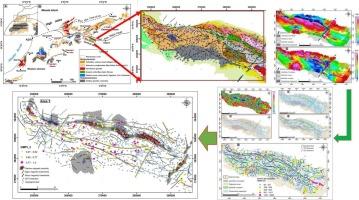通过整合直升机载磁和河流沉积物数据来定位潜在的钴矿床:来自摩洛哥中部Anti-Atlas的Bou Azzer Inlier的见解
IF 3.6
2区 地球科学
Q1 GEOLOGY
引用次数: 0
摘要
这项研究是在位于摩洛哥中部反阿特拉斯链的Bou Azzer-El Graara河进行的。它基于一种方法方法,旨在推断该地区的结构框架,并建立地球化学关联的空间分布,以绘制钴潜力高的地区。为此,对直升机载磁资料和水系沉积物地球化学资料进行了综合分析。磁资料包括残差磁场图(RMI)和降极图(RTP),用于岩性分析。这些地图有助于识别磁异常,其中一些与Bou Azzer蛇绿岩复合体有关,该复合体是钴矿化的宿主。此外,倾斜导数(TDR)和CET变换用于构造目的,实现了面向WNW-ESE, NE-SW和E-W的磁线映射。利用欧拉反褶积法(ED)绘制了磁源深度估计图,显示深度范围从60 m到5900 m。采用因子分析对水系沉积物地球化学数据进行处理,并采用GMPI方法进行细化。该方法确定了三种主要的地球化学关联:第一种关联:Co-As-Au-Cu,第二种关联:Ni-Cr,第三种关联:Fe。利用模糊逻辑对含钴矿化结果进行了深入分析,发现构造复杂性与地球化学异常空间分布具有显著的相关性。该模型以矿产远景图的形式呈现,从而确定了发现新的含钴矿床的五个潜在区域。这种验证强调了在该区域内进行矿物勘探所采用的方法的相关性和效率。本文章由计算机程序翻译,如有差异,请以英文原文为准。

Targeting potential cobalt deposits through integration of helicopter-borne magnetic and stream sediment data: Insights from the Bou Azzer Inlier, Central Anti-Atlas, Morocco
The study was conducted in the Bou Azzer-El Graara inlier, located in the Central Anti-Atlas chain of Morocco. It is based on a methodological approach aimed at deducing the structural framework of the region and establishing the spatial distribution of geochemical associations to map areas with high cobalt potential. To achieve this, a comprehensive analysis of helicopter-borne magnetic and stream sediment geochemical data was carried out. The magnetic data included the residual magnetic field map (RMI) and the reduced-to-pole map (RTP), which were used for lithological analysis. These maps helped with identifying magnetic anomalies, some of which are associated with the Bou Azzer ophiolitic complex that hosts cobalt mineralization. Additionally, the tilt derivative (TDR) and CET transformation were applied for structural purposes, enabling the mapping of magnetic lineaments oriented WNW-ESE, NE-SW, and E-W. A depth estimation map of magnetic sources was also produced using the Euler deconvolution method (ED), revealing depths ranging from 60 m to 5900 m. Stream sediment geochemical data were processed using factor analysis, further refined by the GMPI method. This approach identified three main geochemical associations: first association: Co-As-Au-Cu, second association: Ni-Cr, and third association: Fe. An in-depth analysis of the results using fuzzy logic was carried out on the metallotects of cobaltiferous mineralizations, highlighting a significant correlation between structural complexity and the spatial distribution of geochemical anomalies. This modeling, presented as a mineral prospectivity map, led to the identification of five potential zones for the discovery of new cobaltiferous occurrences. This validation underscores the relevance and efficiency of the methods applied in mineral exploration within the region.
求助全文
通过发布文献求助,成功后即可免费获取论文全文。
去求助
来源期刊

Ore Geology Reviews
地学-地质学
CiteScore
6.50
自引率
27.30%
发文量
546
审稿时长
22.9 weeks
期刊介绍:
Ore Geology Reviews aims to familiarize all earth scientists with recent advances in a number of interconnected disciplines related to the study of, and search for, ore deposits. The reviews range from brief to longer contributions, but the journal preferentially publishes manuscripts that fill the niche between the commonly shorter journal articles and the comprehensive book coverages, and thus has a special appeal to many authors and readers.
 求助内容:
求助内容: 应助结果提醒方式:
应助结果提醒方式:


